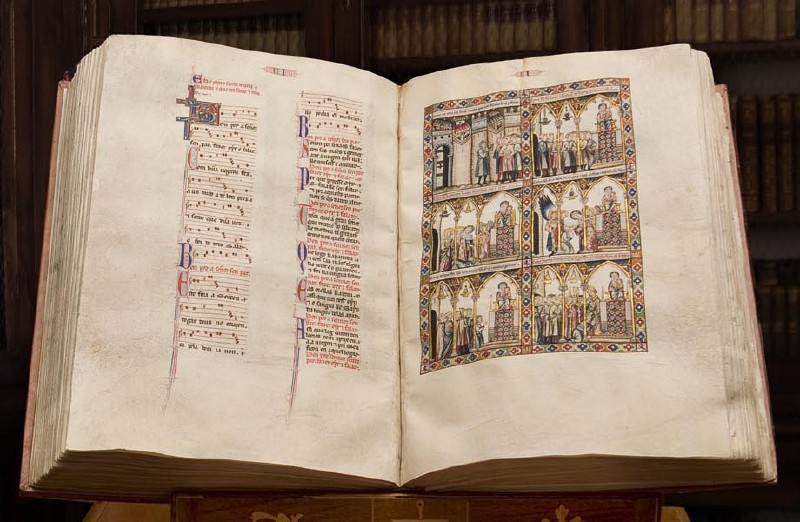| | C a n t i g a s d e A l f o n s o X E l S a b i o New deluxe facsimile of manuscript T.j.1 ("E2") preserved in the Biblioteca del Monasterio El Escorial A magnificent collection of monophonic songs written in Gallician-Portuguese dedicated to the Virgin Mary |  |
|
|  click image for a column illumination | |
|
| El Escorial Ms. T.j.I ("E2")—also known as "Códice Rico"—is the third of four surviving manuscripts that preserve the Cantigas repertoire, settings in a narrative format relating to Marian miracles and festivities. Although incomplete "E2" is considered the most important from the point of view of the miniatures. It is made up of 256 folios of parchment in the elegant French script of 13th-c. codices. Originally it contained 200 cantigas, but the loss of some folios has reduced the count to 196. This codex was lavishly illustrated with 1,257 miniatures on 210 of its folios and depicts a vast array of human typology in Spain during the 13th c. Only one of the illustrations is divided into eight vignettes (the one belonging to the first cantiga), while the others all have six. Two of these miniatures portray important aspects of Alfonso's life and cultural activities. The first one is on fol. 4v and it fills the entire first column. Under a gothic arch supported by two columns, the king is seated with a parchment in his hand with the inscription "Because composing songs is an art which requires great understanding, therefore he who undertakes it must have this quality", which are the words that begin the Prologue B. There are three singers in each of the side arches, four holding parchments in their hands. The second miniature is on fol. 5 where the king is also represented seated under a central arch, with an open book on a table, and in the adjoining arches two scribes write the cantigas the king is dictating to them. The writing shows letters on a musical staff. In the last arch, to the right of the king, stand three musicians with vihuelas de arco and vihuelas de péñola; and in the left one, there are four singers with tonsure. Some scholars argue that El Escorial's "Codice Rico" and the Florentine one (Bibl. Nazionale Centrale, Banco Rari 20) were part of one work that was to contain 300+ cantigas, however there is a difference in the organization of the miniatures in the two sources. The musical notation of the cantigas follows forms similar to that used for Gregorian chant but with some hybrid shapes that give information (ambiguously) on the length of the notes. The metrics of the poems are extraordinarily diverse (280 different forms for all 420 surviving cantigas), the most common being virelai and rondeau. The authorship of the poems are unknown—research has shown that the Galician poet Airas Nunes may have had a part but also King Alfonso X is believed to be the author of some pieces. (adapted and enlarged from H. Salvador Marta-Nez, H. Salvador Martinez, Alfonso X, the Learned: A Biography). | |
| |  |  | | The edition: deluxe facsimile in the original format—512 pages, 35 x 50 cm—bound in full leather. Commentary (2 vols 473/697 pp)by a team of specialists offering essays on filology, history, architecture, luxury commissions, armaments, codicology, musicology, naval engineering, liturgy, & painting. Limited edition of 980 copies worldwide. Published by Testimonio Cie. Madrid and the Patrimonio Nacional in the series Colección Scriptorium. Available now Price : €8,589 Please call for special OMI offer |
|
OMI - Old Manuscripts & Incunabula PO Box 6019 FDR Station, New York NY 10150
tel/fax 212/ 758-1946 • http://www.omifacsimiles.com • immels@earthlink.net